It seems these days that the building blocks of proteins, affectionately known as "amino acids," are viewed as tiny little gold nuggets that bestow superhuman powers upon anyone lucky enough to stumble upon them in a sports gel, capsule, fizzy drink, or cocktail.
After all, these little guys are starting to get put by nutrition supplement manufacturers into just about everything: from your engineered pre-workout snack, to your during workout beverage, to your post-workout smoothie mix.
- But why are amino acids so prevalent now as the "darling" of the supplement industry?
- And more importantly, do amino acids actually work any better or differently than, say, protein powder or eggs or a steak?
- And of course, when it comes to your hard-earned dollars and which supplements you "prioritize," do amino acids really help you exercise or function... or are nutrition supplement companies pulling a fast one on you?
You're about to find out and have a bit of educational fun in the process.
How Amino Acids Work
Think of muscle like a big Lego castle (or Lego pirate ship, depending on your tastes), and amino acids as all the little Lego parts that made up the giant Lego structure (your muscle).
Convenient explanation? Yes. Complete explanation? Not exactly.
See, the role of amino acids goes way beyond being Lego-like building blocks. Amino acids are essential for the synthesis of proteins, enzymes, hormones, neurotransmitters, metabolic pathways, mental stabilization, and just about every function that takes place within your body.
So, using the "Legos-are-amino-acids" example, a more appropriate analogy would be that you dump all the Legos out of the box and they self-assemble in a magic pirate ship, then float into the air and fly around the room shooting miniature cannon balls at pesky flies, fixing holes in the drywall of your house, and then tucking you into bed for a refreshing night of deep sleep.
In other words, the function of amino acids goes far beyond being simple "building blocks."
In the nutrition supplement industry (when I use that word, it seems to denote big fat guys in black suits sitting around an oak conference table, but in reality, most of these folks are skinny athletes in white shoes and geeky shorts), amino acid supplements fall into two basic categories: Essential Amino Acids (EAAs) and Branched Chain Amino Acids (BCAAs).
And there's plenty of confusion about the difference between EAAs and BCAAs.
So let's start with the first category: the EAAs (and by the way, using the acronym like I do will make you seem super smart if you hang around any bros at the gym).
Essential Amino Acids
Essential amino acids, as the name implies, are essential because they can't simply be made by your body like all the other amino acids can. Instead, you have to get EAAs from your diet or other exogenous sources.
Have you ever heard of Private Tim Hall, AKA Pvt. Tim Hall? If you're a biology or chemistry geek, you probably have, because his name is the mnemonic commonly used to remember these essential amino acids, which are, drumroll please:
Phenylanine, Valine, Threonine, Tryptophan, Isoleucine, Methionine, Histidine, Arginine, Leucine and Lysine.
Get it? PVT Tim Hall?
Thanks, Tim. We'll send you a check if we ever win money in Biology Trivial Pursuit.
Anyways, let's take a look at why the heck Pvt. Tim might do us good during exercise, starting with P.
P: Phenylalanine is traditionally marketed for its analgesic (pain-killing) and antidepressant effect, and is a precursor to the synthesis of norepinephrine and dopamine, two "feel-good" brain chemicals. This could be good because elevated brain levels of norepinephrine and dopamine may actually lower your "RPE" or Rating of Perceived Exertion During Exercise, which means you could be happier when you're suffering halfway through a killer workout session, an Ironman bike ride, an obstacle race, or any voluminous or intense event.
V: Valine, along with Isoleucine and Leucine, is a real player because it is BOTH an Essential Amino Acid and a Branched Chain Amino Acid. It can help to prevent muscle proteins from breaking down during exercise. This means that if you take Valine during exercise, you could recover faster because you'd have less muscle damage. More details on that below, when we delve into BCAAs.
T: Threonine research is a bit scant. I personally couldn't find much at all that explained why threonine could assist with exercise performance, but would hazard a guess that it is included in essential amino acid supplements because it is just that: essential. And many of the studies done on EAAs just basically use all of them, rather than isolating one, like Threonine. For example, (and this is a bit interesting for people who are masochistic enough to like working out starved) there is a significant muscle-preserving effect of an essential amino acids supplement when ingested during training in a fasted state, and this includes decreased indicators of muscle damage and inflammation. This basically means that if you popped some essential amino acids, even if you didn't eat anything, you wouldn't "cannibalize" as much lean muscle during a fasted workout session.
OK, sorry, I got sidetracked there.
T: Tryptophan is an interesting one. It is a precursor for serotonin, a brain neurotransmitter that can suppress pain, and if you're taking some before bed at night, it even induces a bit of sleepiness. The main reason to take tryptophan would be to increase tolerance to pain during hard workouts, games or races. But studies to this point go back and forth on whether or not that actually improves performance.
I: Isoleucine, another BCAA that has some of the same advantages of Valine. Again...more on BCAAs coming in a sec.
M: Methionine helps your body process and eliminate fat. It contains sulfur, a substance that is required for the production of the body’s most abundant natural antioxidant, glutathione. Your body also needs plenty of methionine to produce two other sulfur-containing amino acids, cysteine and taurine, which help the body eliminate toxins, build strong, healthy tissues, and promote cardiovascular health. Methionine is a "lipotropic", which means it helps your liver process fats, prevents accumulation of fat in the liver and ensures normal liver function, which is essential for the elimination of toxins from your body. Methionine also supports liver function by regulating glutathione supplies - glutathione is needed to help neutralize toxins in the liver.
H: Histidine, as the name implies, is a precursor to histamine, and actually has some antioxidant properties and plays a key role in carnosine synthesis. What does that mean, exactly? Here's a clarification: histamine could help you fight off the cell-damaging free radicals you produce during exercise, and carnosine helps you get rid of muscle burn more quickly, and helps turn lactic acid back into useable muscle fuel.
A: Arginine, and if you're reading this and you're an old man who has relied on a little blue pill called Viagra to have a happier time in the sack, you can thank arginine. Arginine helps with nitric oxide synthesis, and nitric oxide is a vasodilator that increases blood flow and could help with exercise capacity (in the case of the blue pill, for one specific body part). Most of the studies on arginine show that it also helps folks with cardiovascular disease improve exercise capacity.
L: Leucine is yet another BCAA. Yes, as I keep promising, we will get to BCAAs very soon.
L: Lysine is something my Mom used to take to help cold sores that she got from eating citrusy foods. That's basically because it helps heal mouth tissue. But more importantly for exercising individuals, lysine may actually assist with growth-hormone release, which could vastly improve muscle repair and recovery, although if you take lysine in it's isolated form, the amount you'd have to take to increase growth hormone release would cause gastrointestinal distress, or as I like to call it, sad poopies. But combined with all the other essential amino acids, there may be a growth hormone response in smaller doses, and there is some clinical evidence that essential amino acid supplementation could stimulate growth hormone releasing factors.
OK, that almost wraps it up for good ol' Private Tim Hall.
The only thing I didn't mention is that the EAAs have a bit of an insulin and cortisol increasing effect, which confuses some people as to why EAAs would be good. But before you draw back in shock and go flush all your essential amino acids down the toilet because you heard insulin and cortisol make you fat, remember that both insulin and cortisol are crucial (in smaller amounts) for the "anabolic process", or the growth, repair and recovery of lean muscle tissue.
So the amount of these hormones you get in essential amino acids is far different than the stress and insulin and cortisol response you get from, say, doing burpees with your mother-in-law while eating a pint of ice cream smothered in whiskey while working on an all-nighter project for work.

“I really didn’t realize how crucial essential amino acids were until I ran out of them and didn’t repurchase right away. You feel the difference in your performance and recovery immediately.”
- Justin S (verified buyer)
Branched Chain Amino Acids
Next come BCAAs, the slightly less well-endowed (albeit much cheaper) cousin of EAAs.
BCAAs are quite interesting because they are metabolized in your muscle, rather than in the liver. This means that BCAAs, without any requirement for much digestion or "processing" at all, can be relied on as an actual energy source during exercise, and could, therefore, prevent premature muscle breakdown. There was actually one compelling study done by a guy named Ohtani that showed exercising individuals who got BCAAs had better exercise efficiency and exercise capacity compared to a group that didn't get BCAAs.¹
Other studies have found that BCAAs could increase a variety of factors that are really useful for anyone who cares about their physical performance...like red blood cell count, hemoglobin, hematocrit and serum albumin. They can also lower fasting blood glucose and decrease creatine phosphokinase, which means less inflammation, better red blood cell formation, and better formation of storage carbohydrate.
But that ain't all.
BCAA supplementation after exercise has been shown to cause faster recovery of muscle strength, and even more interestingly, the ability to slow down muscle breakdown even during intense training and "overreaching" (getting very close to overtraining). Just Google the branched chain amino acid studies by Sugita and Kraemer for more on that (yes, shocker, this is a blog post, and not a peer-reviewed scientific journal report with full citations, because if it was the latter, you'd be asleep by now - so if you're a science nazi, then go get busy on Google scholar).
OK, so continuing onto with the many cool things that BCAAs can do...
When you supplement with BCAAs, they can decrease the blood indicators of muscle tissue damage after long periods of exercise, thus indicating reduced muscle damage. They also help maintain higher blood levels of amino acids, which, if you recall from the EAA explanation above, can make you feel happier even when you're suffering hard during exercise. So as you may have guessed, low blood levels of BCAAs are correlated with increased fatigue and reduced physical performance.
Heck, they even use BCAAs in medicine. BCAAs could help people recover from liver disease, could assist with improvements in patients with lateral sclerosis, and could help recovery in patients who have gone through trauma, extreme physical stress (can you say "triathlon," "Crossfit WOD," "obstacle race," or "airline travel?"), kidney failure, and burns.
But here is what I think could be the two most interesting things about BCAAs, especially for fat loss:
1. In his book, "SuperHealth: The Last Diet You'll Ever Need", my friend KC Craichy swears by them for significantly decreasing your appetite when taken 30-60 minutes prior to exercise.
2. When taken prior to a fasted exercise session, BCAAs could increase fat oxidation (and yes, I'll actually cite a study for this one, it was Branched-chain amino acids supplementation enhances exercise capacity and lipid oxidation during endurance exercise after muscle glycogen depletion, by Gualano, et al²)
3. My friend Dominic D' Agostino, ketosis researcher at the University of Florida, swears by BCAAs for maintaining high-intensity performance while in ketosis, a strategy he recently outlined in a recent ketosis podcast with Tim Ferris.
How To Use EAAs and BCAAs
So if you've stayed with me so far, here's the takeaway message about amino acids:
"If all EAAs are present, your appetite is satiated, muscle repair and recovery can start before you're even done with your workout, and when you need a fast, nearly instantly absorbable form of protein or you're mentally stretched toward the end of a tough workout, game or race, high blood levels of amino acids can allow the body and brain to continue to both repair and to work hard instead of getting cannibalized and shutting down."
Based on all this, do I take amino acids?
You bet I do.
And I swear by them for enhancing mental focus during a workout, keeping me from cannibalizing muscle (especially during fasted morning workout sessions), and decreasing post-workout muscle soreness.
When racing triathlons or obstacle races or other long competitive events, I pop 5-10 grams of amino acids per hour, and after hard workouts, I'll pop another 5-10 grams of amino acids, often with a glass of wine (wine, although a tasty post-workout treat to finish off a hard evening workout, sadly does not contain any actual protein, darn it).
I also use these aminos when I can't get my hands on quality protein, such as when I don't have time to make a real meal after a workout, or on a plane flight when the "fish" that gets shoved in front of you in the airline meal appears to be a rubber doggie toy laced with chemicals, or during a week or a day when I'm limiting meat consumption (shocker for bacon enthusiasts: I actually do occasionally limit meat consumption as a longevity-enhancing technique).
Now here's what I didn't tell you yet, and something that is going to save you a ton of trouble when it comes to how many "bottles" of different supplements you use: any essential amino acid blend also contains all the BCAAs. So if you use an EAA formulation that is in the proper ratios, you get every single benefit you just read about in this article, without having to buy both EAAs and BCAAs.
That's why I don't use BCAAs. Not only are they only giving me less than half of the amino acid needs, but they also aren't necessary in a protocol that already includes EAAs. I only use EAAs.
So which amino acids do I personally take?
I can tell you that I do not take the popular brands that have artificial sweeteners like sucralose or added sugars like maltodextrin.
I also do not take any amino acids that don't come in the necessary ratios, because I do not want to completely waste my money.
Instead, I use an essential amino acids blend called Kion Aminos, which comes in a convenient, portable tablet form (as well as tasty Mixed Berry and Cool Lime flavors). Each capsule contains every single amino acid you've just read about in the exact ratios necessary for achieving lean muscle maintenance, immune system health, injury healing, staving off central nervous system fatigue during exercise, controlling food cravings, and every other benefit you've just got done reading about.
So, why are Kion Aminos any different than other protein sources?
It all comes down to quality. The Amino Acid Utilization (AAU™) that Kion Aminos offers is dramatically greater than dietary protein sources.
- At the low end of the spectrum are branched chain amino acids – only 1% of their content is utilized by the body, with 99% resulting in waste that your body must then process and eliminate.
- Food like meat, fish and poultry fare just a bit better, with 32% being absorbed and 68% being wasted.
- Eggs are the winners in the food category with 48% being utilized and 52% converted to waste.
Now…
…compare those numbers to Kion Aminos—a massive 99% is put to work by the body, with only 1% leaving as waste. Not only that, but Kion Aminos is absorbed by the body within 23 minutes.
So this means that unlike, say, meat or eggs or nuts, which can take hours to digest and absorb, Kion Aminos is fully digested within 23 minutes from its ingestion.
On an airplane? I pop 10 with a can of club soda to crush food cravings and keep me from digging around in my bag for chocolate.
Pre-workout? I take 5-10 to fuel my body with 100% plant-based, caffeine-free, clean energy.
Post-workout? I take 5-10 immediately, which is much easier than mixing a protein shake.



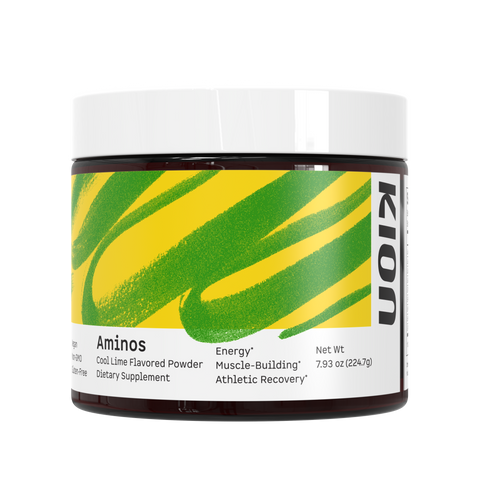
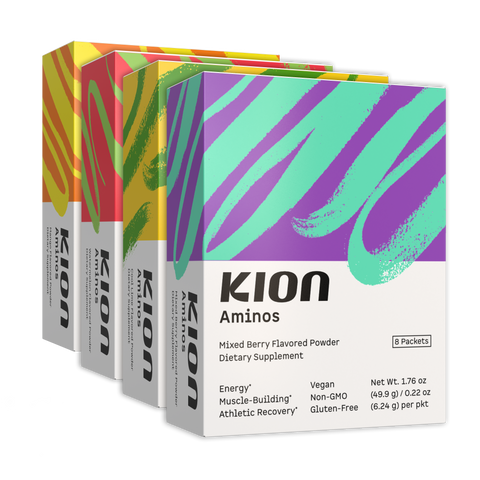
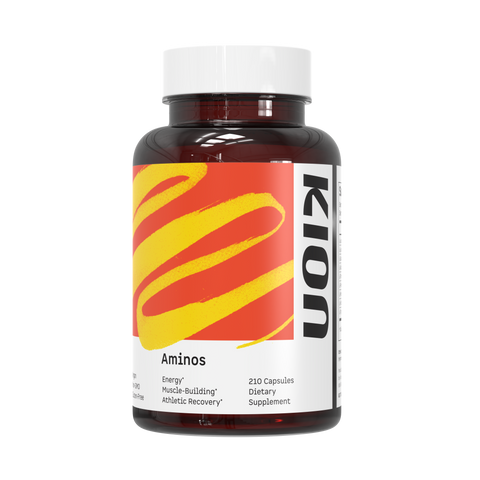
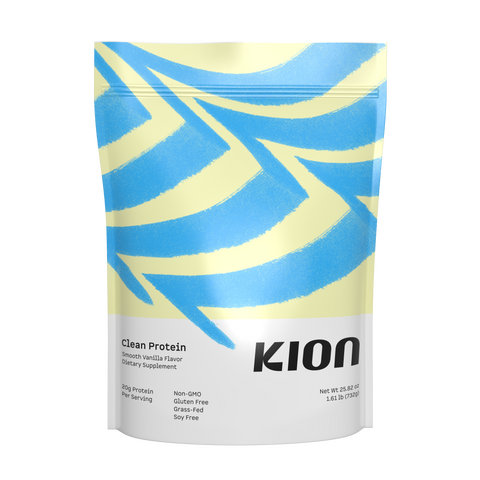
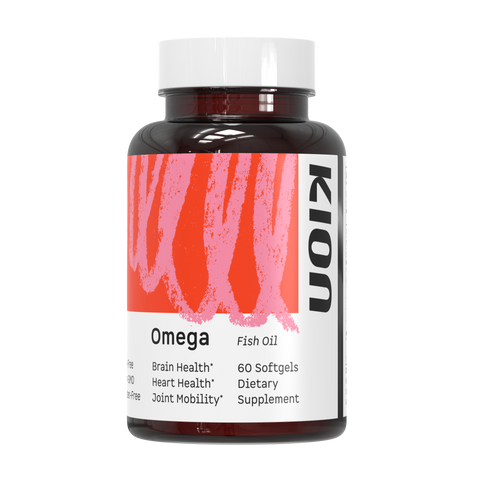
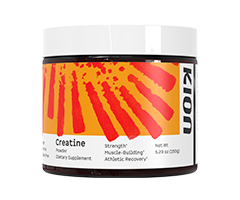
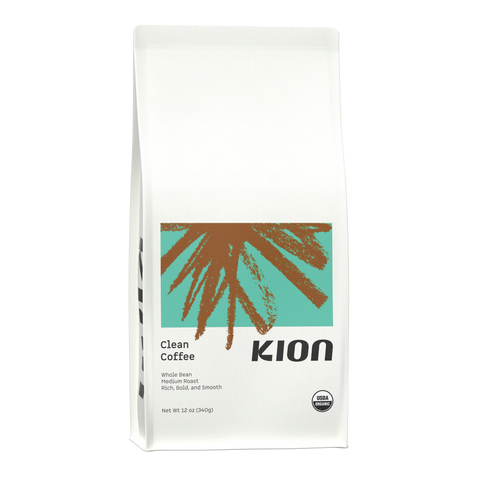
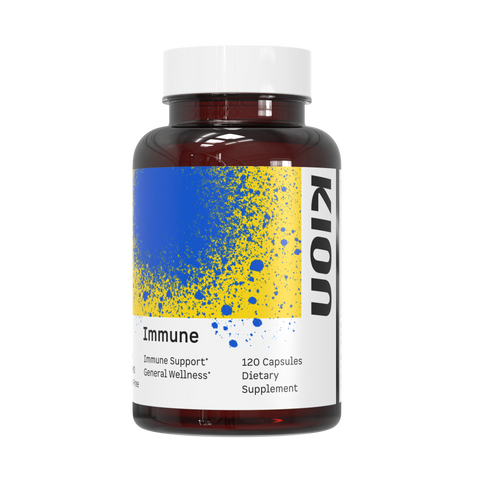




Comments
I take the powder form, and take one scoop in the morning with water and sip on it until noon when I eat lunch. Then take another scoop with water around 5 ish during my workout.
Is this too much?
Thank you for your help.
Daniel
———
Kion replied:
Many studies have shown effective protocols up to and exceeding 100g of EAA’s daily! However, much of the evidence also suggests that 18g taken in a single serving to be the tipping point at which the increase to muscle protein synthesis begins to plateau. We recommend that if one is taking 3 servings of Kion Aminos at the same time multiple times throughout the day, that they be separated by at least 3 hours. So, while no “upper limit” has been established for EAA supplementation in terms of safety, there does seem to be a “soft” upper limit when it comes to efficacy, or more accurately maximal efficacy. If your current protocol of 2 servings daily is working well for you, we support it!
Daniel on